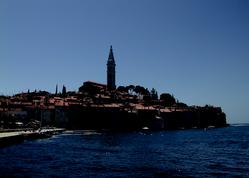- Villa search

- Canaries
- Caribbean
- Croatia, Bulgaria and Hungary
- Cyprus
- Florida
- France and Corsica
- Greece
- Italy
- Lakes and Mountains
- Madeira
- Malta and Gozo
- Portugal
- South Africa
- Spain - Balearics
Information

Rovinj, on the coast
You could spend a happy fortnight relaxing in the peace and beauty of Oprtalj. There's a village shop, a bar, and a restaurant that serves local specialities (Italian-influenced and strong on truffles) in the balcony-style village square. And, if you're interested, the gardener Emilio (or, in Croatian, Emil – everywhere and everyone here seems to have two names) will invite you to his home to taste his malvazija white wine, a bargain at 50 kuna (about £4) for five litres. Sample his honey- and herb- infused liqueur, and view his collection of WW2 army helmets and memorabilia while you're there.
If you do venture further afield, the bigger, better-known hill village of Motovun perches a few miles away on the other side of the Mirna river valley. It's nice, but better still is Groznjan, a once-empty hill village that's been repopulated with musicians and artists. You can't stroll far through its mediaeval streets without hearing exquisite notes drifting down from one practice room or another. Almost every day in summer there's a recital or concert of some sort, and while you're strolling around there are plenty of galleries, cafés and workshops to keep you interested – and ice creams at 30p a cornet.
...better still is Groznjan, a once-empty hill village that's been repopulated with musicians and artists.
If the villages are beautiful, so too is the countryside around them. Away from the 17 main roads to the coast, there is hardly any traffic and there's a real ‘return to nature' feel to the landscape.
Probably only a tenth of the land is actively farmed: in the rest, nature has its own way. The result is a profusion of wild flowers, abundant wildlife (we saw deer, hares and masses of birds) and more butterflies than I have seen anywhere.
Then there's the coast. The limestone terrain doesn't lend itself to great beaches, but the pine-clad slopes running down to rocky coves have their own charm. In many places there are coastal foot- and cycle-paths. There's good bathing from frequent concrete platforms and jetties.
If a bucket-and-spade session is essential, most newer coastal developments have a stretch of artificial beach.
The old coastal towns are the main attraction, though. Rovinj, with its massive hilltop church and Porec, with its 6th century basilica, are the best known and well worth a visit (if you're staying near one, a boat trip to the other, taking in the fjord-like Limski Kanal, costs around £13 including lunch and drinks). They get busy in summer, so if crowds aren't your thing I can recommend Novigrad.
Despite a name that suggests it might be a home of heavy engineering, this is a small, pretty fishing port with lots of appealing restaurants.
We sampled Restaurant Mandrac, which by Croatian standards is pricey but provided superb fish. After an extended lunch it was all we could do to stagger off into the coastal pines and snooze away the afternoon heat.
Interesting and pleasant though the coast is, I suspect visitors who go to the interior are more likely to come back raving about Istria than those who stay near the sea. It may sound corny, but for me the countryside created an almost painful awareness of bygone simplicity and beauty. It makes you realise just how much is lost when countryside is farmed and managed to the last inch.
So as a place to relax and enjoy the simple pursuits of walking, eating, drinking local wines and soaking up the sun, inland Istria is hard to beat. And with luck, the flood of new property owners will bring life to near-dead villages and provide more delightful holiday homes to rent, without spoiling the look and feel of this rural idyll.
Getting there
Istria’s main airport is at Pula, but as yet there are no scheduled flights there from the UK. There are summer charter flights from most UK airports. For instance, from May to October Thomsonfly has flights on Tuesdays from Birmingham, Bristol, Doncaster, Gatwick and Manchester, from £119 return. Flyglobespan has Sunday flights from Edinburgh and Glasgow, from £129 return.
If you want more flexibility over dates, easyJet has daily flights to Rijeka from Bristol and Luton (from £48 return), or for northern Istria you could fly with Ryanair to Trieste in Italy.
For easy, quick information on no-frills flights, try Skyscanner - it’s far faster than going to individual websites. One benefit of flying to Trieste is that car hire is likely to be cheaper there than in Croatia, but make sure when booking cars that cross-border travel is allowed. We used Easyautos to book two cars at Trieste airport with no extra charge for leaving Italy.
home | destinations and editorial | villa search | property for sale | car hire | flights | services
villaseek blog | contact villaseek | links and resources | advertise your villa© Dune Root Ltd and Villaseek.com 2012 - Caribbean
- Canaries